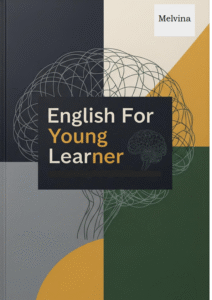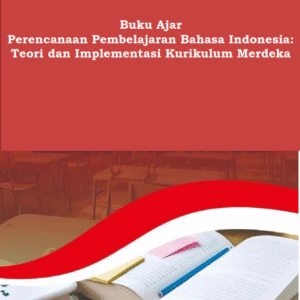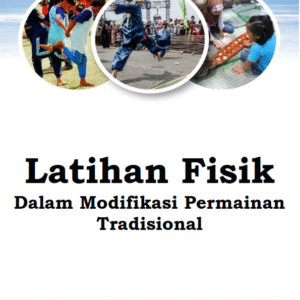| Sinopsisi Buku |
English for Young Learners is a specially designed English learning book aimed at early childhood and primary school students. It offers a fun, interactive, and communicative approach to help young learners naturally acquire and use English from an early age.
Through themes that are closely related to children's everyday lives—such as family, animals, colors, numbers, and school activities—this book helps build essential vocabulary, simple sentence structures, and the development of the four core language skills: speaking, listening, reading, and writing.
Equipped with engaging illustrations, songs, games, dialogues, and interactive exercises, this book aims to spark interest and boost confidence in using English. It is suitable for both classroom and home learning, whether used individually or in groups.
English for Young Learners serves as an ideal learning resource for teachers, parents, and students in building a strong foundation in English language skills from an early age.
|
| Referensi |
Abe, Keiko. 1991. Teaching English to Children in an EFL Setting (The English Teaching Forum). Yokohama, Japan: Kanto Gakuin Women’s College.
Brewster, J., Ellis, G., & Girard, D. (2002). The Primary English Teacher’s Guide. Penguin English.
Brown, H.D. 1987. Principles of Language Learning and Teaching (2nd Ed). New Jersey, Prentice Hall.
Cameron, Lynne. 2003. Teaching English to Young Learners. Cambridge University Press.
Clark, Herbert H. and Clark, Eve V. 1977. Psychology and Language. New York: Harcourt Brace Jovanovich. INC.
Collie, R.J., & Martin, A.J. (2016). Adaptability: An important capacity for effective teachers.Educational Practice and Theory, 38, 27-39. DOI: 10.7459/ept/38.1.03
Hudelson, Sarah. 1991. EFL Teaching and Children: A Topic-Based Approach (The English Teaching Forum). Arizona State University, USA.
Hasnanto, A. T. (2024). Effective Classroom Management to Create a Positive Learning Environment. Journal Corner of Education, Linguistics, and Literature, 4(001), 257-268.
Harmer, J. 2007. How to Teach English. England: Pearson Limited Education.
Krashen, Stephen D. and Terrell, Tracy D. 1983. The Natural Approach. New Jersey: Alemany Press Regent/Prentice Hall.
Luo, X. (2025). The Application of Humor in English Vocabulary Teaching. Literature, Language and Cultural Studies, 1(3), 136-141.
Mamadaliyeva, Z., & Abduvoxobov, F. (2024). Strategies And Methods For Teaching English To Young Children. Journal Of Education, Ethics And Value, 3(11), 19-23.
Maxmudjonova, R. (2024, May). Effective Classroom Management Strategies: Creating A Positive Learning Environment. In Conference Proceedings: Fostering Your Research Spirit (pp. 140-141).
Meriç, E. (2023). Patience as a predictor of teachers’ classroom management skills. International Online Journal of Education and Teaching (IOJET), 10(2), 959-982.
Nugroho, H. R. A., Nafiah, K., Hutagaol, R. T. S., & Sirait, C. C. (2025). Implementing Proactive Classroom Management in an Effective Classroom Management Approach for Students in Schools. Jurnal Inovasi Pembelajaran Karakter, 10(1).
Nuralisa, N., & Nirwanto, R. (2023). Role Of Teaching Materials On English For Young Learners. PUSTAKA: Jurnal Bahasa dan Pendidikan, 3(4), 01-12.
Odiljonova, S. (2024). Effective Classroom Management Strategies: Tips For Maintaining A Positive Learning Environment For Language Learners. O ‘zbekiston davlat jahon tillari universiteti konferensiyalari, 682-685.
Piccolo, Louanne. 2010. TEYL – Teaching Young Children English. Journal Suite 101, April 10th 2019
Pinter, A. (2006). Teaching Young Language Learners. Oxford University Press.
Pratama. M. T. P., & Gandana, I. (2024). The Use Of Silent Way Through Digital Flashcards: Benefits And Challenges. Eltin Journal: Journal of English Language Teaching in Indonesia, 12(1), 34-43.
Scott, Wendy A. and Ytreberg, Lisbeth H. 1993. Teaching English to Children. Longman
Scott, W. A., & Ytreberg, L. H. (1983). Teaching English to Children. Longman.
Tomlinson, B. (2012). Materials development for language learning and teaching. Language teaching, 45(2), 143-179.,
Yulmiati, Y., & Melvina, M. (2022). An Analysis Of Humor In Classroom Interaction. Social Sciences Review and Humanities, 1(2), 121-129.
Bennett, S. & Maton, K. (2010). Beyond the 'digital natives' debate: Towards a more nuanced understanding of students' technology experiences. Journal of Computer Assisted Learning. 26(5), 321-331. https://doi.org/10.1111/j.1365-2729.2010.00360.x
Education Week. (2022). What Is Culturally Responsive Teaching? URL: https://www.edweek.org/teaching-learning/culturally-responsive-teaching-culturally-responsive-pedagogy/2022/04. Access at 11 June 2025.
Gonzalez, N. (2020). Culturally Responsive Teaching: Theory, Research, and Practice. New York: Teachers College Press.
Hwang, G.J. & Chang, H.F. (2019). A review of mobile technology in education: A focus on the impact of mobile learning on students' learning outcomes. Educational Technology & Society. 22(1), 1-12.
Hollie, S. (2017). Culturally and Linguistically Responsive Teaching and Learning: Affirming Young Learners. (2nd ed.). New York: Routledge.
OECD. (2023). Digital equity and inclusion in education. URL: https://one.oecd.org/document/EDU/WKP(2023)14/en/pdf. Access at 11 June 2025.
Radesky, J. S., Schermerhorn, A. C., & Eisenberg, M. H. (2016). Mobile and interactive media use by young children: The good, the bad, and the unknown. Pediatrics. 138(5), e20162591. https://doi.org/10.1542/peds.2016-2591
Smith, J. (2023). The Impact of Technology on English Learning for Young Learners. Journal of Language Education. 15(2), 45-60. https://doi.org/10.1234/jle.2023.0152
Vygotsky, L. S. (1978). Mind in Society: The Development of Higher Psychological Processes. Cambridge, MA: Harvard University Press
|








Reviews
There are no reviews yet.